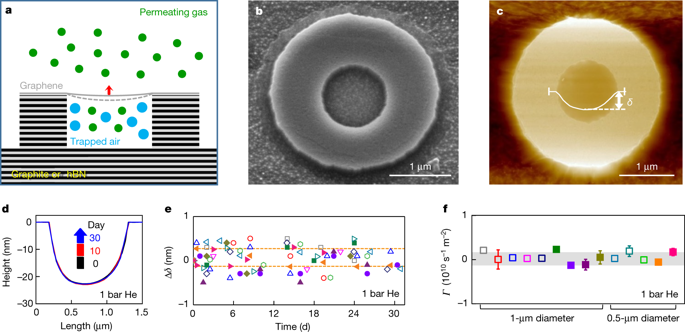Nature ( IF 50.5 ) Pub Date : 2020-03-11 , DOI: 10.1038/s41586-020-2070-x P Z Sun 1, 2 , Q Yang 1, 2 , W J Kuang 1 , Y V Stebunov 1, 2 , W Q Xiong 3 , J Yu 4 , R R Nair 2 , M I Katsnelson 4 , S J Yuan 3, 4 , I V Grigorieva 1 , M Lozada-Hidalgo 1 , F C Wang 1, 2, 5 , A K Geim 1, 2

|
Despite being only one-atom thick, defect-free graphene is considered to be completely impermeable to all gases and liquids1,2,3,4,5,6,7,8,9,10. This conclusion is based on theory3,4,5,6,7,8 and supported by experiments1,9,10 that could not detect gas permeation through micrometre-size membranes within a detection limit of 105 to 106 atoms per second. Here, using small monocrystalline containers tightly sealed with graphene, we show that defect-free graphene is impermeable with an accuracy of eight to nine orders of magnitude higher than in the previous experiments. We are capable of discerning (but did not observe) permeation of just a few helium atoms per hour, and this detection limit is also valid for all other gases tested (neon, nitrogen, oxygen, argon, krypton and xenon), except for hydrogen. Hydrogen shows noticeable permeation, even though its molecule is larger than helium and should experience a higher energy barrier. This puzzling observation is attributed to a two-stage process that involves dissociation of molecular hydrogen at catalytically active graphene ripples, followed by adsorbed atoms flipping to the other side of the graphene sheet with a relatively low activation energy of about 1.0 electronvolt, a value close to that previously reported for proton transport11,12. Our work provides a key reference for the impermeability of two-dimensional materials and is important from a fundamental perspective and for their potential applications.
中文翻译:

石墨烯不透气性的限制
尽管只有一个原子厚,但无缺陷的石墨烯被认为对所有气体和液体1、2、3、4、5、6、7、8、9、10完全不可渗透。该结论基于理论3、4、5、6、7、8,并得到实验1、9、10的支持,该实验无法在 10 5到 10 6的检测限内检测到气体渗透通过微米尺寸的膜每秒原子数。在这里,我们使用用石墨烯紧密密封的小型单晶容器,证明无缺陷的石墨烯是不可渗透的,其精度比之前的实验高 8 到 9 个数量级。我们能够辨别(但没有观察到)每小时只有几个氦原子的渗透,这个检测限也适用于所有其他测试的气体(氖、氮、氧、氩、氪和氙),除了氢. 氢显示出明显的渗透性,尽管它的分子比氦大,并且应该经历更高的能垒。这一令人费解的观察归因于一个两阶段过程,该过程涉及分子氢在催化活性石墨烯波纹中的离解,11,12。我们的工作为二维材料的不渗透性提供了关键参考,并且从基本角度及其潜在应用来看非常重要。

































 京公网安备 11010802027423号
京公网安备 11010802027423号